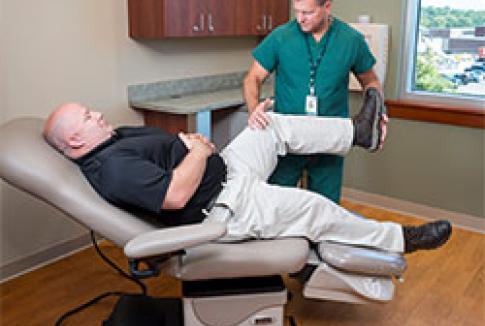
Everything Chiropractic
What is Chiropractic?
According to the American Chiropractic Association (ACA), Chiropractic is a health care profession that focuses on disorders of the musculoskeletal system and the nervous system, and the effects of these disorders on general health. Chiropractic services are used most often to treat neuromusculoskeletal complaints, including but not limited to back pain, neck pain, pain in the joints of the arms or legs, and headaches.
What is a Doctor of Chiropractic?
Doctors of Chiropractic (DCs) – often referred to as chiropractors or chiropractic physicians – practice a hands-on, drug-free approach to health care that includes patient examination, diagnosis and treatment. Chiropractors have broad diagnostic skills and are also trained to recommend therapeutic and rehabilitative exercises, as well as to provide nutritional, dietary and lifestyle counseling.
DCs may assess patients through clinical examination, laboratory testing, diagnostic imaging and other diagnostic interventions to determine when chiropractic treatment is appropriate or when it is not appropriate. Chiropractors will readily refer patients to the appropriate health care provider when chiropractic care is not suitable for the patient’s condition, or the condition warrants co-management in conjunction with other health care providers.
In many cases, such as lower back pain, chiropractic care may be a patient's primary method of treatment. When other medical conditions exist, chiropractic services may complement or support medical treatment by relieving the musculoskeletal aspects associated with the condition.
Like their MD colleagues, doctors of chiropractic are subject to the boundaries established in state practice acts and are regulated by state licensing boards. Further, their education in four-year doctoral graduate school programs is nationally accredited through an agency that operates under the auspices of the U.S. Department of Education. After graduation, they must pass national board exams before obtaining a license to practice, and then must maintain their license annually by earning continuing education (CE) credits through state-approved CE programs.
What is Spinal Manipulation?
One of the most common and well known therapeutic procedures performed by doctors of chiropractic is spinal manipulation (sometimes referred to as a "chiropractic adjustment"). The purpose of spinal manipulation is to restore joint mobility by manually applying a controlled force into joints that have become hypomobile – or restricted in their movement – as a result of a tissue injury. Tissue injury can be caused by a single traumatic event, such as improper lifting of a heavy object, or through repetitive stresses, such as sitting in an awkward position with poor spinal posture for an extended period of time. In either case, injured tissues undergo physical and chemical changes that can cause inflammation, pain, and diminished function for an individual. Manipulation, or adjustment of the affected joint and tissues, restores mobility, thereby alleviating pain and muscle tightness, allowing tissues to heal.
Chiropractic adjustment rarely causes discomfort. However, patients may sometimes experience mild soreness or aching following treatment (as with some forms of exercise) that usually resolves within 12 to 48 hours. Compared to other common treatments for pain, such as over-the-counter and prescription pain medications, chiropractic's conservative approach offers a safe and effective option.
Why Choose Chiropractic?
- It is estimated that, annually, doctors of chiropractic (DCs) treat more than 30 million Americans (adults and children).
- DCs are licensed to practice in all 50 states and the District of Columbia--and in many nations around the world--and undergo a rigorous education in the healing sciences at institutions accredited by the U.S. Department of Education.
- A growing list of research studies and reviews demonstrate that the services provided by chiropractic physicians are both safe and effective. The evidence strongly supports the natural, whole-body and cost-effective approach of chiropractic services for a variety of conditions..
- Chiropractic services are included in most health insurance plans, including major medical plans, workers’ compensation, Medicare, some Medicaid plans, and Blue Cross Blue Shield plans for federal employees, among others.
- Chiropractic is used extensively by amateur and professional athletes to prevent and treat injuries as well as achieve optimal health and functioning.
There are just some of the reasons that people are turning to chiropractic services to get and stay healthy and pain free. Chiropractic is a health care profession that focuses on disorders of the musculoskeletal system and the nervous system, and the effects of these disorders on general health. Chiropractic care is used most often to treat neuromusculoskeletal complaints, including (but not limited to) back pain, neck pain, pain in the joints of the arms or legs, and headaches.
Doctors of Chiropractic – also referred to as chiropractors or chiropractic physicians – practice a hands-on, drug-free approach to health care that includes patient examination, diagnosis and treatment. Chiropractors have broad diagnostic skills and are perhaps best known for their expertise in the use of spinal manipulation; however, they are also trained to recommend therapeutic and rehabilitative exercises, and to provide nutritional, dietary and lifestyle counseling.
Chiropractic Qualifications
Educational and licensing requirements for doctors of chiropractic (DCs) are among the most stringent of any of the health care professions.
DCs are educated in nationally accredited, four-year doctoral graduate school programs through a curriculum that includes a minimum of 4,200 hours of classroom, laboratory and clinical internship, with the average DC program equivalent in classroom hours to allopathic (MD) and osteopathic (DO) medical schools.
They are designated as physician-level providers in the vast majority of states and federal Medicare program. The essential services provided by DCs are also available in federal health delivery systems, including those administered by Medicaid, the U.S. Departments of Veterans Affairs and Defense, Federal Employees Health Benefits Program, Federal Workers' Compensation, and all state workers' compensation programs.
Chiropractic Education
The typical applicant at a chiropractic college has already acquired nearly four years of pre-medical undergraduate college education, including courses in biology, inorganic and organic chemistry, physics, psychology and related lab work. Once accepted into an accredited chiropractic college, the requirements become even more demanding — four to five academic years of professional study are the standard. Because of the hands-on nature of chiropractic, and the intricate adjusting techniques, a significant portion of time is spent in clinical training.
Chiropractors undergo a rigorous education in the healing sciences, similar to that of medical doctors. In some areas, such as anatomy, physiology, rehabilitation, nutrition and public health, they receive more intensive education than their MD counterparts. Like other primary health care doctors, chiropractic students spend a significant portion of their curriculum studying clinical subjects related to evaluating and caring for patients. Typically, as part of their professional training, they must complete a minimum of a one-year clinical-based program dealing with actual patient care. In total, the curriculum includes a minimum of 4,200 hours of classroom, laboratory and clinical experience. The course of study is approved by an accrediting agency that is recognized by the U.S. Department of Education. This has been the case for more than 25 years.
This extensive education prepares doctors of chiropractic to diagnose health care problems, treat the problems when they are within their scope of practice and refer patients to other health care practitioners when appropriate.
Certification and Licensure
Certification and licensure of chiropractors is governed by the National Board of Chiropractic Examiners (NBCE). DCs must pass a board exam and then obtain a license in the state in which they wish to practice. Chiropractors must meet yearly continuing education requirements to maintain their licensure.
What Research Shows About Chiropractic
A growing list of research studies and reviews demonstrate that the services provided by chiropractic physicians are clinically effective, safe and cost effective. Following are excerpts and summaries from a few of those studies. The evidence supports the natural, whole-body, drug-free approach of chiropractic for a variety of conditions.
To find more research supporting chiropractic services, visit the World Federation of Chiropractic's Reading List. Here are some examples of the excellent and ever expanding results seen with chiropractic care.
For Acute and Chronic Pain
“Many treatments are available for low back pain. Often exercises and physical therapy can help. Some people benefit from chiropractic therapy or acupuncture.”
Goodman et al. (2013), Journal of the American Medical Association
“[Chiropractic Manipulative Therapy] in conjunction with [standard medical care] offers a significant advantage for decreasing pain and improving physical functioning when compared with only standard care, for men and women between 18 and 35 years of age with acute low back pain.”
Goertz et al. (2013), Spine
In a Randomized controlled trial, 183 patients with neck pain were randomly allocated to manual therapy (spinal mobilization), physiotherapy (mainly exercise) or general practitioner care (counseling, education and drugs) in a 52-week study. The clinical outcomes measures showed that manual therapy resulted in faster recovery than physiotherapy and general practitioner care. Moreover, total costs of the manual therapy-treated patients were about one-third of the costs of physiotherapy or general practitioner care.
Korthals-de Bos et al (2003), British Medical Journal
“Patients with chronic low-back pain treated by chiropractors showed greater improvement and satisfaction at one month than patients treated by family physicians. Satisfaction scores were higher for chiropractic patients. A higher proportion of chiropractic patients (56 percent vs. 13 percent) reported that their low-back pain was better or much better, whereas nearly one-third of medical patients reported their low-back pain was worse or much worse.”
Nyiendo et al (2000), Journal of Manipulative and Physiological Therapeutics
In Comparison to Other Treatments
"Manual-thrust manipulation provides greater short-term reductions in self-reported disability and pain compared with usual medical care. 94% of the manual-thrust manipulation group achieved greater than 30% reduction in pain compared with 69% of usual medical care."
Schneider et al (2015), Spine
"Reduced odds of surgery were observed for...those whose first provider was a chiropractor. 42.7% of workers [with back injuries] who first saw a surgeon had surgery, in contrast to only 1.5% of those who saw a chiropractor."
Keeney et al (2012), Spine
“Acute and chronic chiropractic patients experienced better outcomes in pain, functional disability, and patient satisfaction; clinically important differences in pain and disability improvement were found for chronic patients.”
Haas et al (2005), Journal of Manipulative and Physiological Therapeutics
“In our randomized, controlled trial, we compared the effectiveness of manual therapy, physical therapy, and continued care by a general practitioner in patients with nonspecific neck pain. The success rate at seven weeks was twice as high for the manual therapy group (68.3 percent) as for the continued care group (general practitioner). Manual therapy scored better than physical therapy on all outcome measures. Patients receiving manual therapy had fewer absences from work than patients receiving physical therapy or continued care, and manual therapy and physical therapy each resulted in statistically significant less analgesic use than continued care.”
Hoving et al (2002), Annals of Internal Medicine
For Headaches
“Cervical spine manipulation was associated with significant improvement in headache outcomes in trials involving patients with neck pain and/or neck dysfunction and headache.”
McCrory, Penzlen, Hasselblad, Gray (2001), Duke Evidence Report
“The results of this study show that spinal manipulative therapy is an effective treatment for tension headaches. . . Four weeks after cessation of treatment . . . the patients who received spinal manipulative therapy experienced a sustained therapeutic benefit in all major outcomes in contrast to the patients that received amitriptyline therapy, who reverted to baseline values.” ‘
Boline et al. (1995), Journal of Manipulative and Physiological Therapeutics
For Neck Pain
In a study funded by NIH’s National Center for Complementary and Alternative Medicine to test the effectiveness of different approaches for treating mechanical neck pain, 272 participants were divided into three groups that received either spinal manipulative therapy (SMT) from a doctor of chiropractic (DC), pain medication (over-the-counter pain relievers, narcotics and muscle relaxants) or exercise recommendations. After 12 weeks, about 57 percent of those who met with DCs and 48 percent who exercised reported at least a 75 percent reduction in pain, compared to 33 percent of the people in the medication group. After one year, approximately 53 percent of the drug-free groups continued to report at least a 75 percent reduction in pain; compared to just 38 percent pain reduction among those who took medication.
Bronfort et al. (2012), Annals of Internal Medicine
Cost Effectiveness
Findings from a study utilizing data from the North Carolina State Health Plan collected between 2000-2009 show that care by a doctor of chiropractic (DC) alone or DC care in conjunction with care by a medical doctor (MD) incurred “appreciably fewer charges” for uncomplicated lower back pain than MD care with or without care by a physical therapist.
Hurwitz et al. (2016), Journal of Manipulative and Physiological Therapeutics
Older Medicare patients with chronic low back pain and other medical problems who received spinal manipulation from a chiropractic physician had lower costs of care and shorter episodes of back pain than patients in other treatment groups. Patients who received a combination of chiropractic and medical care had the next lowest Medicare costs, and patients who received medical care only incurred the highest costs.
Weeks et al (2016), Journal of Manipulative and Physiological Therapeutics
Low back pain initiated with a doctor of chiropractic (DC) saves 40 percent on health care costs when compared with care initiated through a medical doctor (MD), according to a study that analyzed data from 85,000 Blue Cross Blue Shield (BCBS) beneficiaries in Tennessee over a two-year span. The study population had open access to MDs and DCs through self-referral, and there were no limits applied to the number of MD/DC visits allowed and no differences in co-pays. Researchers estimated that allowing DC-initiated episodes of care would have led to an annual cost savings of $2.3 million for BCBS of Tennessee. They also concluded that insurance companies that restrict access to chiropractic care for low back pain treatment may inadvertently pay more for care than they would if they removed such restrictions.
Liliedahl et al (2010), Journal of Manipulative and Physiological Therapeutics
“Chiropractic care appeared relatively cost-effective for the treatment of chronic low-back pain. Chiropractic and medical care performed comparably for acute patients. Practice-based clinical outcomes were consistent with systematic reviews of spinal manipulative efficacy: manipulation-based therapy is at least as good as and, in some cases, better than other therapeusis.”
Haas et al (2005), Journal of Manipulative and Physiological Therapeutics
Patient Satisfaction
“Chiropractic patients were found to be more satisfied with their back care providers after four weeks of treatment than were medical patients. Results from observational studies suggested that back pain patients are more satisfied with chiropractic care than with medical care. Additionally, studies conclude that patients are more satisfied with chiropractic care than they were with physical therapy after six weeks.”
Hertzman-Miller et al (2002), American Journal of Public Health
Widespread Use of Chiropractic
“Chiropractic is the largest, most regulated, and best recognized of the complementary and alternative medicine (CAM) professions. CAM patient surveys show that chiropractors are used more often than any other alternative provider group and patient satisfaction with chiropractic care is very high. There is steadily increasing patient use of chiropractic in the United States, which has tripled in the past two decades.”
Meeker, Haldeman (2002), Annals of Internal Medicine
Patient Satisfaction and Clinical Effectiveness
- Chiropractic outperformed all other back pain treatments, including prescription medication, deep-tissue massage, yoga, pilates, and over-the-counter medication therapies.13
- Doctors of Chiropractic (DCs) are the highest rated healthcare practitioner for low-back pain treatments above physical therapists (PTs), specialist physician/MD (i.e., neurosurgeons, neurologists, orthopaedic surgeons), and primary care physician/MD (i.e., family or internal medicine).14
- Doctors of Chiropractic (DCs) provide a patient-centered, whole person approach to health care marked by greater interaction and better communication, resulting in consistently higher patient satisfaction ratings than medical doctors.15
- Doctors of Chiropractic (DCs) are utilized by all 32 National Football League teams16 in optimizing the functionality, endurance and overall conditioning of professional football players in the treatment of neuromusculoskeletal strain injuries, including neck pain, low back pain, strains to hamstrings and quadriceps, and whiplash injuries.
- With prescription pain drug abuse now classified as an epidemic17 in the United States and the number of spinal fusions soaring 500% over the last decade,18 the essential services provided by Doctors of Chiropractic (DCs) represent a primary care approach for the prevention, diagnosis and conservative management of back pain and spinal disorders that can often enable patients to reduce or avoid the need for these riskier treatments.
- Injured workers with similar injuries are 28 times less likely to have spinal surgery if the first point of contact is a Doctor of Chiropractic (DC), rather than a surgeon (MD).19
- A recent study showed that treatment for low back pain initiated by a Doctor of Chiropractic (DC) costs up to 20 percent less than when started a MD.20
- Chiropractic care has an excellent safety record.21 This should be viewed in the context of other treatments for back pain such as steroids,22 pain medications23 and surgery.24 As a result, Doctors of Chiropractic (DCs) pay malpractice premiums at significantly lower rates than allopathic doctors (MDs).25
- The Doctor of Chiropractic (DC) collaborative, whole person-centered approach reflects the changing realities of health care delivery, and fits well into Accountable Care Organization (ACO) and patient-centered, medical home (PCMH) models bringing greater clinical efficiency, patient satisfaction and cost savings.26
- A systematic review in 2010 found that most studies suggest spinal manipulation achieves equal or superior improvement in pain and function when compared with other commonly used interventions for short, intermediate, and long-term follow-up.27
- The American College of Physicians and the American Pain Society jointly recommended in 2007 that clinicians consider spinal manipulation for patients who do not improve with self-care options.28
References
[1] National Board of Chiropractic Examiners (NBCE) www.NBCE.org. Accessed December 2013.
[2] Federation of Chiropractic Licensing Boards (FCLB) www.FCLB.org Accessed December 2013.
[3] Association of Chiropractic Colleges, www.acc.org. Accessed December 2013.
[4] Council on Chiropractic Education (CCE) www.cce-usa.org is the agency certified by the U.S. Department of Education to accredit doctoral graduate school programs who offer Doctor of Chiropractic (D.C.) degree; Accessed December 2013.
[5] Association of Chiropractic Colleges, www.acc.org. Accessed December 2013.
[6] American Chiropractic Association (ACA) www.ACAtoday.org and Federation of Chiropractic Licensing Boards (FCLB) www.FCLB.org 2013.
[7] Certified Chiropractic Clinical Assistant (CCCA) program. Federation of Chiropractic Licensing Boards (FCLB), 2013.
[8] Barnes, Bloom, Nahin. CDC National Health Statistics Report #12. Complementary and Alternative Medicine Use among Adults and Children: United States, 2007. December 10, 2008. Extrapolated to 2013 U.S. population from 2007 National Health Interview Survey (NHIS) finding that 8 percent of the adults and 3 percent of the children in the United States received chiropractic services annually.
[9] Council on Chiropractic Education (CCE) www.cce-usa.org 2013.
[10] Meeker, DC, MPH; Scott Haldeman, DC, PhD, MD; Chiropractic: A Profession at the Crossroads of Mainstream and Alternative Medicine. 2002; 136(3): 216-227. http://annals.org/article.aspx?articleid=474085
[11] Coulter, Adams, Coggan, Wilkes, Gonyea. A Comparative Study of Chiropractic and Medical Education. Alternative Therapy Health Medicine. 1998; 4:64-75.
[12] American Chiropractic Association (ACA), 2013. http://www.acatoday.org/pdf/physicianstatus.pdf
[13] Consumer Reports Health Ratings Center. Back-Pain Treatments. ConsumerReports.org; July 2011.
[14] Consumer Reports Health Ratings Center. Relief for your aching back: What worked for our readers. ConsumerReports.org; March 2013.
[15] Gaumer G, PhD. Factors associated with patient satisfaction with chiropractic care: survey and review of the literature. JMPT 2006 July-Aug; 29(6):455
[16] Professional Football Chiropractic Society (PFCS) 2010 www.profootballchiros.com
[17] Unintentional Drug Poisoning in the United States. Centers for Disease Control and Prevention, 2010. Prescription Drug Abuse. White House Office on National Drug Policy. Accessed November 2013.
[18] Whoriskey, Keating. Boom in spinal fusions questioned. Washington Post. Page 1. October 28, 2013; Rise in spinal fusion surgeries driven partly by financial incentives. Washington Post. November 13, 2013.
[19] Keeney BJ; Fulton-Kehoe D; Turner JA; Wickizer TM; Chan KC; Franklin GM; Early Predictors of Lumbar Spinal Surgery After Occupational Back Injury; Results from a Prospective Study of Workers in Washington State. Spine, May 2013; 38(11):953-64. http://www.ncbi.nlm.nih.gov/pubmed/23238486
[20] Richard L. Liliedahl, Michael D. Finch, David V. Axene, Christine M. Goertz. Cost of Care for Common Back Pain Conditions Initiated with Chiropractic Doctor vs. Medical Doctor/Doctor of Osteopathy as First Physician: Experience of One Tennessee-Based General Health Insurer. Journal of Manipulative and Physiological Therapeutics; November 2010; 33(9):640-643.
[21] Stevinson, MS & Ernst, MD, PhD (2002). Risks Associated With Spinal Manipulation. The American Journal of Medicine, 112(7), 566-571.
[22] Dabbs, Lauretti. A Risk Assessment of Cervical Manipulation vs. NSAIDs for the Treatment of Neck Pain. Journal of Manipulative Physiology and Therapeutics. 1995 October; 18(8):530-6.
[23] Bronfort, Evans, Anderson, Svendsen, Bracha, Grimm. Spinal Manipulation, Medication, or Home Exercise with Advice for Acute and Subacute Neck Pain – A Randomized Trial. Annals of Internal Medicine. January 2012; 156:1-10.
[24] Dekutoski, MD, Norvell, PhD,, Dettori, PhD, Fehlings, MD, PhD, & Chapman, MD (2010). Surgeon Perceptions and Reported Complications in Spine Surgery. Spine, 35(9S).
[25] NCMIC, 2013. https://www.ncmic.com/ Shaw. Avoiding Risky Business. American Chiropractic Association. Accessed December 2013. http://www.acatoday.org/content_css.cfm?CID=1967
[26] Accountable Care Organizations Optimize Outcomes, Cost Savings and Patient Satisfaction with Chiropractic Care. Foundation for Chiropractic Progress. May 2013.
[27] Dagenais S, Gay RE, Tricco AC, Freeman MD, Mayer JM (2010). NASS Contemporary Concepts in Spine Care: Spinal manipulation therapy for acute low back pain. The Spine Journal 10 (10): 918–940.
[28] Chou R, Qaseem A, Snow V et al. Recommendation 7. Diagnosis and treatment of low back pain: a joint clinical practice guideline from the American College of Physicians and the American Pain Society. Annals of Internal Medicine 147 (7): 478–91.
SOURCE: AMERICAN CHIROPRACTIC ASSOCIATION
What to expect on your first visit
Many new patients are not sure what to expect during their first appointment with a Doctor of Chiropractic (DC). Chiropractors start by taking a patient’s history and then performing a physical examination to develop a working diagnosis.
Learn more about what to expect >

Frequently Asked Questions
What conditions do chiropractors treat? How do I select a doctor of chiropractic? Is chiropractic treatment safe? Get answers to these questions and more here.
Read our FAQs >


